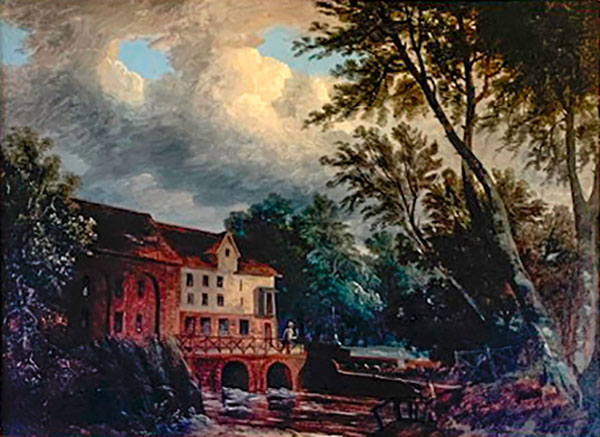
|
Narborough Mill
River Nar |
 |
Oil painting by Henry Ladbrooke - c.1840 |
Narborough Mill
was rebuilt before 1776, although several additions, renovations and modifications
have been undertaken since then. The last structure was built of brick and was 3 storeys high with a single lucum and a pantiled roof. It has distinctive large
recessed brick arches. The rear still has some weathboarding left from an earlier structure. |
Royal Exchange Fire Insurance policy 69447 |
Jas. Loomb of Narborough in the County of Norfolk, Mealman. On his Dwelling House & Offices adjoining brick built & tiled, £400. On Household Furniture therein, £160. On Wearing Apparel in the same, £30. On his Water Millhouse adjoining with Chambers over the same & on the Mills in the said Millhouse together with the running tackle & other parts of the Machinery belonging thereto brick & timber built & tiled, £400. On Utensils & Goods in Trade in the same, £400. On an Outhouse & Cheese Chamber over it brick & tiled, £20. On the 4 Stall Stable brick built & tiled, £40. On the Team Horse Stable brick built & thatch'd, £50. The said Buildings being situate near each other in Narborough aforesd. - Return £1-1 for 8 Months 2 Weeks unexpired time on No. 47140. 6th December 1776 |
Charles Tyssen enlarged the mill in 1845 with a poorly built extension, the foundations of which slowly sank over many years until part of the roof collapsed in 1980. This complete section, along with the Victorian miller's house built onto the front, had to be demolished. Thirteen fifty-foot piles had to be sunk in order to make the building safe when restoration began. |
The 1897 plan shows an engine house on the front of the building. This was
converted into the miller's residence soon after. At that time the tributary
was then made wider and deeper than the parallel stretch of the Nar, providing
an adequate fall of water and more power to drive the wheel. |
 |
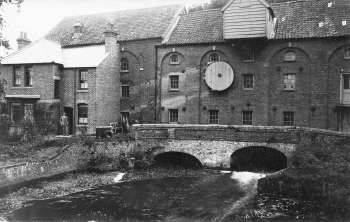 |
c.1900 |
c.1910 |
In 2007 the building still contained its machinery and had been listed. It has been the source of considerable archaeological interest over the years and several detailed studies have been carried out. Some of the information gathered is detailed on a separate page that is linked below. |
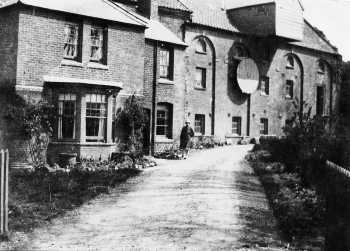 |
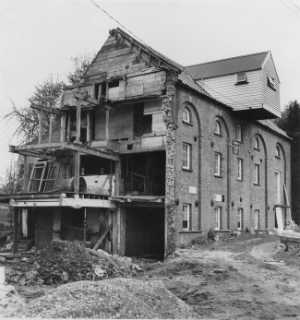 |
|
c.1920
showing the miller's house
|
1980 demolition of the 1845 extension |
|
Originally
the 14' cast iron waterwheel drove 4 sets of stones. At an unknown date
the horizontal mainshaft was extended to take a further 2 sets of stones. A bevel gear cast in 8 sections was also installed to carry drive power through to the first floor. These gears were retoothed in 1950-1 in order to drive a 1905 high speed multi-mill on the first floor. However, it appears the mill ceased to work at about that time. |
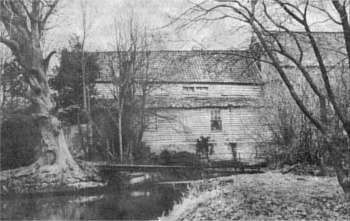 |
 |
|
28th
January 1977 - back of the mill
|
24th April 1977 |
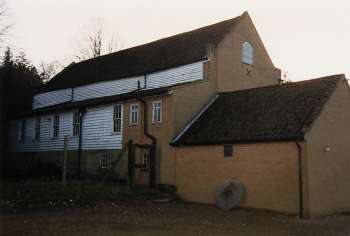 |
|
c.1997
|
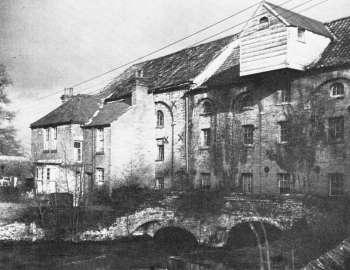 |
 |
|
c.1960
|
27th October 2002 |
Jas. Loomb of Narborough in the County of Norfolk, Mealman. On his Dwelling House & Offices adjoining brick built & tiled, £400. On Household Furniture therein, £160. On Wearing Apparel in the same, £30. On his Water Millhouse adjoining with Chambers over the same & on the Mills in the said Millhouse together with the running tackle & other parts of the Machinery belonging thereto brick & timber built & tiled, £400. On Utensils & Goods in Trade in the same, £400. On an Outhouse & Cheese Chamber over it brick & tiled, £20. On the 4 Stall Stable brick built & tiled, £40. On the Team Horse Stable brick built & thatch'd, £50. The said Buildings being situate near each other in Narborough aforesd. - Return £1-1 for 8 Months 2 Weeks unexpired time on No. 47140. |
Lease and Release in Trust. (1) Abraham Sewell, senior, late of Shouldham, now of Swaffham, grocer; Joseph Ransome, late of Wereham, now of Great Yarmouth, miller; surviving Trustees of Lease and Release dated 13-14 Nov 1741. (2) John Birkbeck of King's Lynn, banker; Joseph Loombe of Narborough, miller; Abraham Sewell, junior, of Swaffham, grocer; Richard Ransome of Westacre, miller; John Langley, junior, of Wereham, woolcomber; John Hallam of Middleton, Norfolk, miller; Thomas Gales of King's Lynn, druggist; Zachariah Clarke of Deaver, Norfolk, yeoman. |
 |
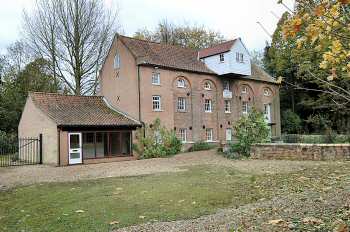 |
|
c.1975
|
27th October 2002
|
|
In 1751 an Act of Parliament authorised the ...making of the River Nar navigable, from the Town and Port of Kings Lynn, to Westacre in the county of Norfolk. The navigation opened in 1759 and was used to bring in coal, grain and bones from Kings Lynn by horse drawn lighters or barges. Return cargoes included sand and gravel from Pentney pits and bonemeal fertilizer from Narborough Bone Mill. The Marriott family were Lords of the Manor from 1857 - 1875 and proprietors of the navigation. Besides owning the wharf and maltings, they were also corn and coal merchants. Navigation above Narborough possibly ceased by the early nineteenth century. In 1881 the Marriotts sold the navigation to the Nar Valley Drainage Board who, as part of a projected drainage scheme, soon built a sluice at Kings Lynn that made further use of the Nar for navigation impossible. Thus the majority of commercial traffic on the Nar had ceased to operate by about 1885. |
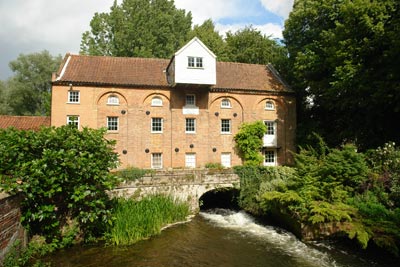 |
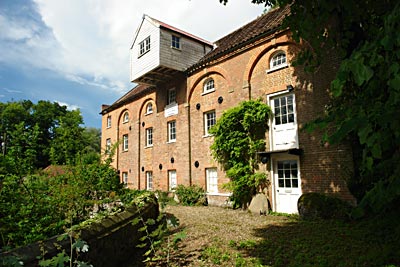 |
9th July 2007 |
|
Robert Everett snr, a gentleman from Wymondham, married Sarah Frith in Derbyshire (she mentions her brother Philip Frith). They had 4 children (possibly not born in the order shown). 1. Joseph Everett, miller at Westacre_mill married Martha Bloomfield in 1823 and they had a son, Joseph Frith Everett c.1824. However they both died, leaving Joseph Frith Everett an orphan at the age of 2. 2. Robert Everett jnr who is mentioned in his father's will of 1835 will got the remainder of his father's estate - that which had not been placed in Trusts etc. Robert & Harriet (née Bradfield) Everett were the parents of Frith Everett, who was born at Narborough in 1824. Robert was miller at Narborough and also at West_Acre after his brother Joseph died c.1826. 3. John Everett, who had Henry & Jane - were also mentioned in the will of 1835. 4. Ann Everett who was obviously single in 1833 when the will was written but may have married later. |
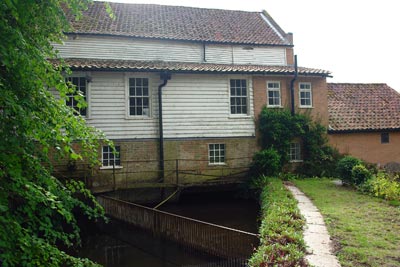 |
Rear of mill 9th July 2007 |
Frith Everett was the son of Robert & Harriet Everett, he was born in 1824 and baptised at Narborough on 29th Febriuary 1824 where his father was miller. Frith Everett married Emily Fisher King. |
| Robert Everett later worked in partnership with his son, Frith Everett and they ran Narborough watermill in conjunction with Gaywood towermill, Homeland Road, King's Lynn until Robert died in 1870. |
Re ROBERT EVERETT & SON Notice is hereby given that the Partnership lately subsisting between Robert Everett & Frith Everett, both of Narborough in the county of Norfolk, in the business of Millers, Merchants & Bakers, carried on at Narborough & Gaywood_Mills in the said county, determined on the 28th day of May last by the death of the said Robert Everett & that the Business is now carried on by the said Frith Everett alone. And all persons having any Claims or Demands against the late Partnership Firm are requested to send particulars of their respective Claims & Demands to the said Frith Everett forthwith & all persons who stood indebted to the said Partnership Firm are requested to pay the amount of their respective debts to the said Frith Everett forthwith. Dated this 20th day of September 1870 T. G. Archer Solr. To the Executor of the said Robert Everett & the said Frith Everett |
|
Norfolk, NARBOROUGH & GAYWOOD IN NARBOROUGH Lot 2. Residence … Lot 3. Dwelling houses … IN GAYWOOD Norfolk Chronicle & Lynn Advertiser 21st July 1883 |
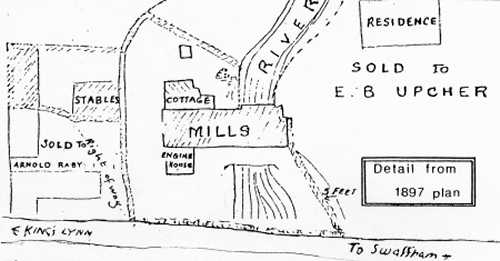 |
|
1897 site map |
|
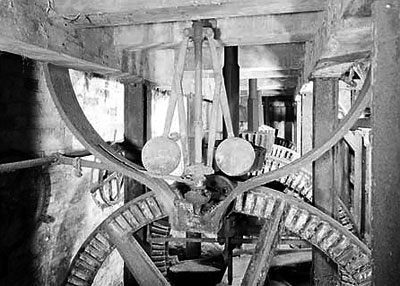 |
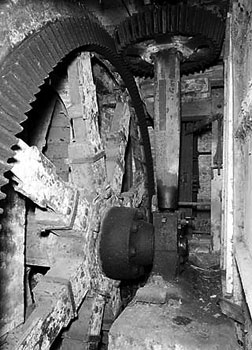 |
Pit wheels 1977 and September 1980 |
|
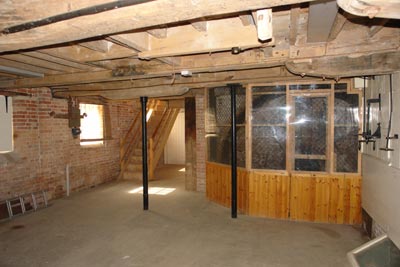 |
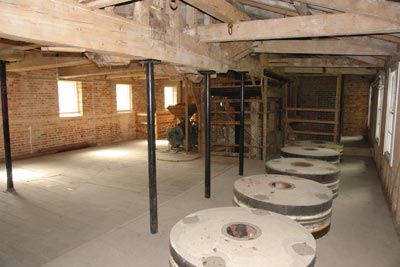 |
9th July 2007 |
|
In
1897 Frith Everett made a deed of Assignment for the benefit of his creditors:
"Conveyance of freehold Water mill and hereditaments situate of Narborough. Mortgages of Mr. Frith Everett to Lt. Col. Wm. Herring. Default having been made by Frith Everett on money owing for the mortgage Margaret Elizabeth Pumpfre Howes of Thorpe St, Andrew (Norfolk) Spinster + Charles Forster of the City of Norwich who were the mortgages put up the property for sale at public auction at the Globe Hotel, King's Lynn, 31st August 1897. Lot 2 (The Mill) was sold to Wm. Herring for £150. Consisting of Water Mill, with cartshed, stables and other buildings. Also the wheels gring (sic) gear iron and brass work apparatus and machinery belonging to the Mill." |
Machinery of the past may revolve again |
As it weaves its way through West Norfolk, the A47 - Norfolk's artery into the Midlands - is alive with industrial and commercial traffic carrying goods and raw materials to meet the modern needs of the Seventies. But passing through the village of Narborough, the traffic thunders past a reminder of a bygone era. But during the autumn new interest was generated in the mill with the exciting possibility of its being given a new lease of life. Since it was formed in August last year, the society's membership has grown to twelve. The first report was the work of a nucleus of five active members. The mill at Narborough was chosen as the group's first study because the machinery inside is still largely complete, and for that reason quite rare.The group are keen to record the area's industrial heritage before it disappears through neglect and decay. The owner of the Mill, Mr. Brian Ash, of Park Cottage, Narborough, has dreams of preserving the mill and restoring it to working order. One idea he is toying with is open it as a museum in which ancient farm implements could be exhibited alongside the machinery. The museum, he feels, could also be incorporated in a fishing centre. But an ambitious scheme of that nature would obviously require considerable finance to make it a practical proposition. Mr. Ash feels that the report will be a valuable aid to him in the future if he applies for a grant for the mill's restoration. Although he is enthusiastic about such a project taking shape, his more immediate concern is the mill's state of repair. He said part of the roof was in danger of collapse, and was causing concern. But the archaeology group do not consider themselves preservationists. Mr. Anthony Beaumont, also a founder member, who was responsible for writing the report, explained that the society's role was to provide a written and photographic record of the area's industrial heritage before it disappeared. "It's up to the owner of the property concerned to try to restore a particular building. We do not have the necessary finances for this work," he said. The report on the mill is a comprehensive account. It includes detailed information on the internal machinery, much of which is still intact. Other aspects covered included location, history, the buildings and their state of repair. It is illustrated with plans, drawings, photographs and a map of its location. A series of technical drawings has been produced by Mr. Vic Walker, who used to work at Savages, the old Lynn engineering firm. A copy of the report is available for inspection at Lynn Museum. |
Narborough Mill - Report No. 1 from the N.W. Norfolk & King's Lynn Branch: Narborough Water Mill The account was written by Tony Beaumont with additional notes and drawings by Bob Trett. For further information on the work of the Group, contact King's Lynn Museum or the Secretary, M.W. Skerritt, 29 Winfarthing Avenue, King's Lynn. The Group would like to thank Mr. B. Ash, the owner, for his help and for permission to inspect the mill. Mr. Ash also lent the old photographs of the mill and his deeds to assist the Survey. The modern photographs were provided by Messrs. Beaumont and Tuck. Narborough Water Mill, TF 7472 1320 - King's Lynn and District Archaeology Society Study, Sept - Nov 1976. Location Surroundings; waterways The long lake at Narford Hall appears to provide the main steady water supply to the mill and the Nar has an entry and exit in this lake. There is also a 'by-pass' to the mill water and this overflow runs round the north side of the mill, joining the river near the main millwheel outfall through a culvert. (It should be noted that another arm or branch of the Nar passes under the main road about 200 yards north of the mill.) Building (1780?) State of repair Machinery - general Originally the cast iron water wheel drove four sets of stones through spur and bevel gears using cast iron/wood teeth. At an unknown date, the horizontal mainshaft was extended to take two more sets of stones and the same gearing. The extension coupling between the mainshaft and the extension is completely fractured. (Many wood teeth are missing from the extension shaft bevel wheels.) The governor gear is inoperative and the governor bevels are worn and do not mesh. Attached to the main drive spur ring is a later cast iron bevel gear ring (cast in eight sections). This drives a vertical shaft carrying further wooden toothed bevels at the first floor level. These gears were re-toothed by Savages Ltd. in 1950/1(?) for the purpose of driving a 1905 high-speed 'multi-mill' on the first floor. This work appears to have been of very short duration and since then the mill has never worked. The multi-mill and its drive shafts and belting are all complete. There is considerable amount of derelict light seed dressing and grading machinery on the first floor. It is thought that only this light machinery was driven by a steam engine at one time, situated in the present residence marked 'engine house' on the 1897 plan. There is now no evidence of a steam drive apart from an old concrete-filled firebox lying in front of the mill. A large pulley-like wheel is on the front of the mill wall. It is considered now that this was not an engine drive pulley but a dust extraction fan in a casing, probably driven from inside the mill from a convenient shaft. N.B. The 1910 photograph at the head of the main page would appear to dispute this theory as it clearly shows the drive belt from the engine house attached to the pulley. The sack hoists inside the mill are certainly the original design and material. The drive to the chain sack hoists is effected by a crude but still working lever and rope system whereby the drive pulley for the belt is raised and lowered. All this mechanism is complete and almost certainly dates from the building of the mill in 1780(?). Millstones Water slackers Water wheel It would seem that the basic mechanism of the mill would operate with the bevel pinions driving the stones which were screw operated out of mesh. The mill is now owned by Mr. B. Ash, resident in Narborough, who owns a trout farm higher up the River Nar. The 'engine house' residence was until recently occupied and part of the ground floor of the mill is maintained in a reasonably clean condition and used for the resident's storage, etc. Conclusion Narborough Water Mill - list of inscriptions noted |
Excerpt from Listed Buildings sheet: Former watermill. Late C18 with late C20 repairs. Brick, carstone and weatherboarding with pantile and corrugated iron roofs. 3 storeys with attic. 5 bays to which a sixth was added to north side in late C20 after the demolition of C19 additions. 4 bays recessed within giant enclosing arches. The arches are semicircular headed with raised ashlar keystones and imposts. Ground and first floor windows with glazing bars beneath skewback arches. Southernmost bay with ground and first floor doorways. Second floor has 4 pivot windows with glazing bars beneath semicircular arches. The central window is rectangular beneath a skewback arch. Dentil cornice. Central weatherboarded lucum with corrugated iron roof. Carstone rubble south gable-end. Rear wall weatherboarded with a continuous outshut housing machinery. Sluice gates beneath a 3-centred arch. 5 C20 sash windows with glazing bars in outshut. Bridge to front with 2 3-centred arches and a swept parapet. |
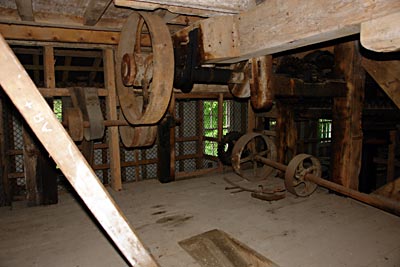 |
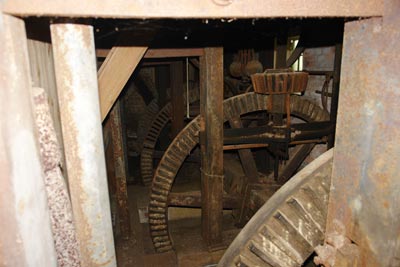 |
Auxiliary drive pulleys 9th July 2007 |
Centre shaft 9th July 2007 |
Watermill attracts torrent of interest
|
One of Norfolk's historic watermills is on the market - and the owners have been taken aback by the interest. The Georgian mill at Narborough, near Swaffham, last ground flour in 1950 and is one of the few in the country to keep its waterwheel and a complete set of machinery. After it stopped working, it became near-derelict but was restored by Rex Carter Farms. Chairman Nicholas Carter admitted there was a sadness in letting go of a building where their restoration won a Norfolk Society Award from the Council for the Protection of Rural England in 1982 and which is Grade II listed. It was used in connection with the Narborough Trout Fishery, now owned by David Baker, and inside still has the waterwheel and five huge millstones in the milling room. Mr Carter said there had been tremendous interest since the building was put on the market on August Bank Holiday. People had looked at it withy ideas of using it as a home, as a restaurant - and one milling enthusiast wanted to bring the mill back to some kind of working life so it could be shown to the public. The building is being sold by Bidwells of Norwich and Cambridge with an asking price of over £75,000. Eastern Daily Press - 1993 |
Frith Everett was my great-grandfather. His father, Robert Everett, acquired the Narborough property after the death of Robert's uncle, Phillip Frith, who left Robert the Narborough property around 1846, I think. Before that time Robert and his brother, Joseph, apparently ran the mill at West Acre. They were born in Wymondham, where their father was a grocer. Robert, his wife, Harriet, Joseph and his wife, Martha, are all buried at West Acre. Robert may also have owned a mill at Gaywood. Robert had a son called Frederick, who lived in Swaffham and was in business with Robert's son-in-law, Richard Vynne. They may well have owned the maltings, which one stood across the road from the mill. Frith never returned to Norfolk. He died at the home of his son, my grandfather, Robert Bradfield Everett, in Kerrville, Texas and was buried there.
My father's name is Ned Everett - he is 93 years old, the last of the Everetts and lives in Hollister, California. His father, Robert Bradfield Everett, had six boys and they are all gone except for him. None of Robert's siblings had children. Louise Graham, Lexington, Kentucky, USA - 21st April 2005 |
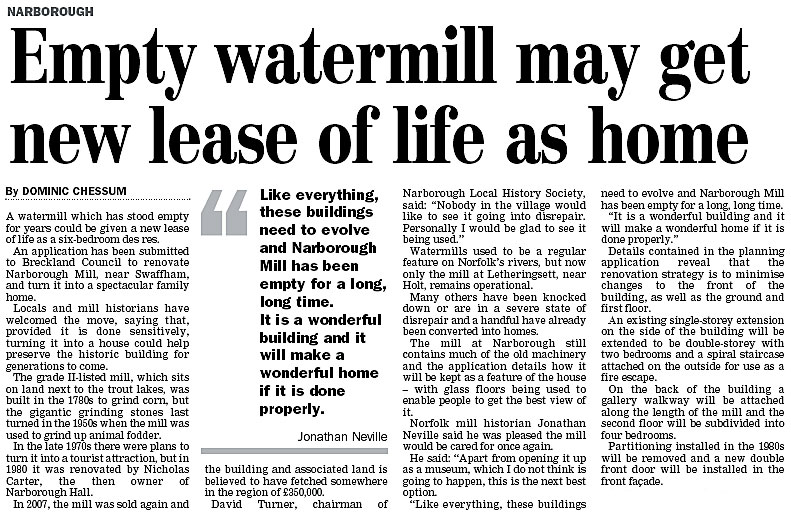 |
Eastern Daily Press article - 19th August 2009 |
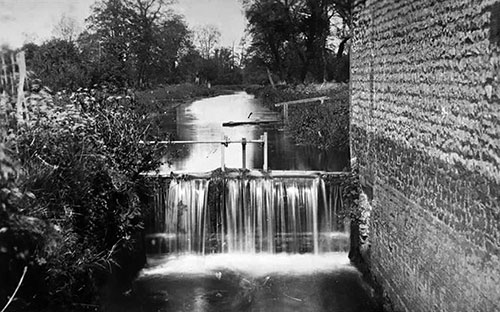 |
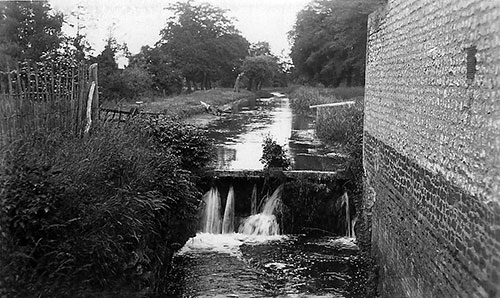 |
Penn Sluice from Ship Bridge c.1920
|
Penn Sluice from Ship Bridge c.1924 |
Penn Sluice was built opposite the Ship Inn in Narborough. The Ship Bridge was built so barges could carry on up river to West acre. The bridge was high enough for barges to pass under. |
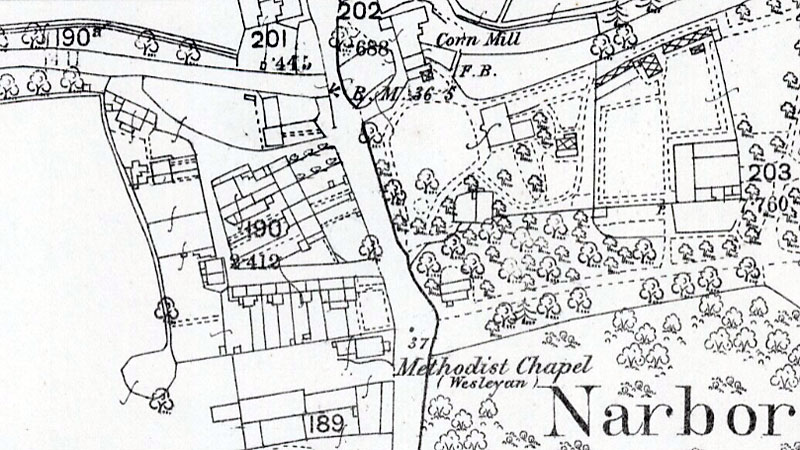 |
O. S. Map 1884 |
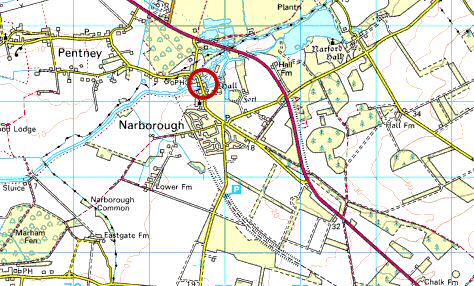 |
O.S. Map 2005 Image produced under licence from Ordnance Survey |
|
1514: Sir John
Spelman was left the manor of Narborough ... including the water mill 1824: Robert Everett, miller White's 1854:
Frith Everett, corn miller and merchant, Narborough water mill and wharf, where much business is transacted in coal, timber, corn, malt etc.
Kelly's 1883: Frith Everett
1993: Mill advertised for sale by Bidwells for in excess of £75,000 |
If you have any memories, anecdotes or photos please let us know and we may be able to use them to update the site. By all means telephone 07836 675369 or
|
| Nat Grid Ref TF7471 1319 | Copyright © Jonathan Neville 2003 |